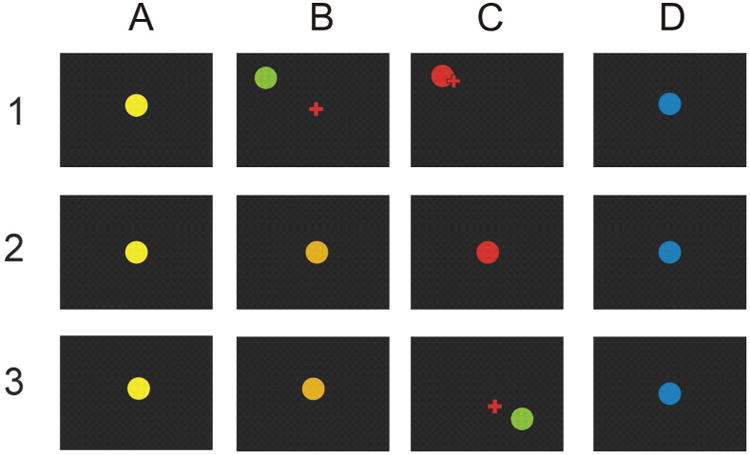Figure 1.

The three phases of the study. Phase 1: Identification of a pre-movement SMR feature correlated with performance. A. A yellow or blue target appears in the center of the screen. B. After 1-7 sec, the target appears at a random location and a cursor appears in the center. C. The subject uses the joystick to move the cursor to the target and then presses the select button, at which point the target turns red if the cursor is in contact with the target. The screen then goes blank for 1 sec prior to the next trial. If the cursor does not reach the target within 2 sec, the screen simply goes blank for 1 sec prior to the next target. D. The next trial begins. Phase 2: Training of the SMR feature identified in Phase 1. A. A yellow or blue target appears in the center of the screen, cueing SMR feature reduction or increase, respectively (see text). B. Target color changes as the SMR feature amplitude approaches criterion. C. Red signals success and the screen goes blank; if the criterion is not reached, the screen simply goes blank. D. One sec later, the next trial begins. Phase 3: consisting of Phase 2 followed by Phase 1. A. A yellow or blue target appears in the center of the screen, cueing SMR feature reduction or increase, respectively (see text). B. Target color changes as the SMR feature amplitude approaches criterion. C. If and when the criterion is reached, the joystick task is initiated with the target appearing at a random location and the cursor appearing in the center. As with phase 1, the subject uses the joystick to move the cursor to the target and then presses the select button, at which point the target turns red for 0.5 sec and the screen then goes blank for 1 sec prior to the next trial. If the cursor does not reach the target within 2 sec, the screen simply goes blank for 1 sec prior to the next trial. D. The next trial begins.
